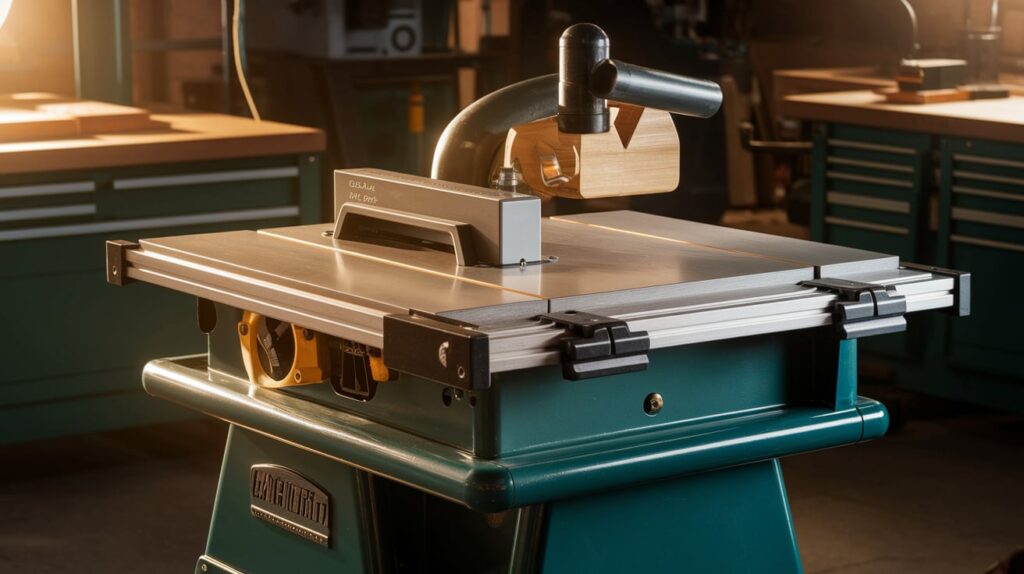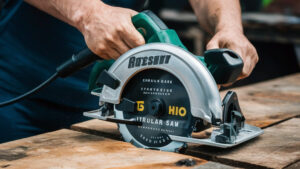Moving a cabinet table saw can be a daunting task, especially if you’re unsure where to begin. But don’t worry; you’re not alone in this.
Whether you’re relocating to a new workshop or simply rearranging your space, safely moving your table saw is crucial. You might be concerned about damaging this valuable piece of equipment or even injuring yourself in the process. What if you could move it with ease, knowing exactly what steps to take?
By the end of this guide, you’ll not only understand how to move your cabinet table saw securely and efficiently, but you’ll also feel confident in your ability to tackle this task without a hitch. Let’s transform this seemingly overwhelming job into a straightforward, manageable process.
Preparation Steps
Moving a cabinet table saw demands careful preparation. Proper planning ensures safety and efficiency. This section outlines the key steps to prepare for the move. Follow these steps to avoid potential mishaps and damage.
Assess The Saw’s Size And Weight
First, evaluate the saw’s dimensions and weight. This helps in understanding the effort needed. Check the manufacturer’s manual for accurate specifications. Knowing the weight helps in choosing the right moving equipment.
Gather Necessary Tools And Materials
Collect essential tools and materials before starting. You may need a dolly or hand truck. Gather moving straps or ropes for secure handling. Ensure you have protective gear like gloves and sturdy shoes. These tools ensure a smooth and safe move.
Clear The Pathway
Inspect the path from the saw’s current location to its new spot. Remove any obstacles or debris that could cause tripping. Ensure doorways are wide enough for easy passage. A clear path reduces the risk of accidents and damage.

Safety Precautions
Moving a cabinet table saw requires careful planning and attention. Ensuring safety is crucial during the process. Proper precautions protect you and the equipment.
In this section, we’ll discuss important safety measures. These include wearing protective gear, using proper lifting techniques, and securing the saw blade.
Wear Protective Gear
Protective gear is essential when moving heavy tools. Gloves safeguard your hands from rough surfaces. Safety glasses shield your eyes from debris.
Wear steel-toed boots to protect your feet from accidents. A hard hat can also be helpful, especially if working in tight spaces. Gear up to stay safe.
Ensure Proper Lifting Techniques
Incorrect lifting can cause injuries. Bend your knees when lifting heavy objects. Keep the load close to your body for better control.
Do not twist your body while lifting. Instead, pivot your feet to change direction. Consider using a dolly or moving straps to ease the process.
Secure The Saw Blade
Before moving, ensure the saw blade is secure. Lock the blade in place to prevent accidental movement. Check the blade guard for proper installation.
Remove any loose parts that might fall during transport. This prevents damage and keeps the moving process smooth. Safety first, always.
Disassembly Techniques
Disassembly techniques make moving a cabinet table saw easier and safer. Start by removing the saw blade and motor. Detach the table legs and any additional attachments. Carefully label and store screws and small parts. Proper disassembly ensures a smooth moving process and protects the saw from damage.
Moving a cabinet table saw is no small feat. Understanding the right disassembly techniques can save you time and prevent damage. Whether you’re relocating to a new workshop or rearranging your space, disassembling your saw with care ensures it functions perfectly once reassembled. Here, we’ll explore key steps to safely disassemble your cabinet table saw, focusing on removing the table extension, detaching the fence system, and unplugging and securing cords.
Remove The Table Extension
Start by removing the table extension. This part adds significant weight and can make the saw awkward to move. Using a wrench, carefully unscrew the bolts that attach the extension to the main table.
Have you ever tried to lift a table saw with the extension still attached? It’s like trying to carry a too-big sofa through a narrow doorway. Once the bolts are removed, lift the extension off gently and set it aside. This simple step reduces the saw’s weight and bulk, making it easier to maneuver.
Detach The Fence System
Next, focus on the fence system. It’s crucial for precise cuts, but not necessary for transport. Loosen the clamps or screws that hold the fence to the table. Carefully lift it off and store it safely.
Imagine arriving at your new location only to find your fence damaged because it was left attached. It’s a frustrating oversight. Detaching the fence protects it from damage and ensures it remains aligned and effective when you set up again.
Unplug And Secure Cords
Before moving, unplug all cords. This step might seem obvious, but it’s often overlooked in the rush. Secure the cords using ties or tape to prevent them from snagging or getting tangled during transport.
Think about this: cords left unsecured can catch on corners or get pinched, leading to frustrating electrical issues later. Taking a moment to secure them now can save you from unnecessary headaches. Always check that the saw is completely powered down before handling the cords to ensure safety.
Disassembling your cabinet table saw might seem daunting, but breaking it into manageable tasks makes the process straightforward and stress-free. What other strategies have you found effective when moving bulky workshop tools?
Lifting And Moving
Moving a cabinet table saw requires careful planning and secure lifting techniques. Use a dolly or heavy-duty cart for safe transport. Enlist help to prevent accidents, ensuring the saw stays stable throughout the move.
Moving a cabinet table saw can seem daunting. Yet, with the right techniques, it becomes manageable and safe. The key is to plan how you’ll lift and move it without injury or damage. Let’s break it down into actionable steps to make the process smooth and efficient.
###
Use A Dolly Or Hand Truck
A dolly or hand truck is your best friend when moving heavy equipment. Secure the table saw on the dolly using sturdy straps. This ensures stability and prevents it from tipping over.
Make sure the path is clear of obstacles. A smooth pathway makes maneuvering easier and reduces the risk of accidents. If you’ve ever tried moving bulky furniture, you know how valuable a clear path can be.
###
Employ Additional Helpers
Enlist the help of a few friends or family members. More hands mean better control and less strain on your back.
Coordinate movements with your helpers to avoid miscommunication. A simple plan can prevent mishaps and ensure everyone is on the same page. Have you ever noticed how teamwork simplifies tasks that seem overwhelming alone?
###
Navigate Tight Spaces
Tight spaces require careful navigation. Measure doorways and hallways to ensure the saw fits through. This avoids getting stuck halfway through.
Tilt the saw slightly if needed, but always maintain control. Practice patience here; rushing can lead to accidents. How often do we rush through tight spots only to face setbacks?
By focusing on these steps, you can move your cabinet table saw safely and efficiently. Remember, a little preparation goes a long way in ensuring a smooth move.
Reassembly Process
Moving a cabinet table saw involves careful disassembly and reassembly. First, detach removable parts to lighten the load. Once moved, ensure all components are securely reattached for safe operation.
Reassembling your cabinet table saw is a crucial step in ensuring it functions correctly after a move. Whether you’re setting it up in a new workshop or simply rearranging your space, getting everything back in place can be a bit daunting. However, with a few clear steps, you can get your saw up and running smoothly.
###
Reattach The Table Extension
Start with reattaching the table extension. This piece is essential for supporting larger pieces of wood. Secure it using the bolts or fasteners you removed earlier.
Double-check that it’s level with the main table. This ensures accurate cuts every time. A simple spirit level can be your best friend here.
###
Reconnect The Fence System
The fence system is your guide for straight cuts. Reconnect it by aligning it with the miter slots. Make sure it locks firmly without wobbling.
Test its alignment by sliding it along the table. If it feels rough or sticks, check for debris or misalignment. A well-aligned fence is crucial for precision.
###
Test The Saw For Stability
Stability is key for safe operation. Push gently on the saw from different angles to ensure it doesn’t wobble. If it moves, adjust the leveling feet or place shims under the base.
Power it up and listen for any unusual noises. Vibration or odd sounds might indicate loose components. Wouldn’t you want every cut to be smooth and precise?
Reassembly might seem like a chore, but it’s the final step to get your workspace back in order. What other tips do you have for ensuring a safe and successful reassembly?
Post-move Maintenance
Transporting a cabinet table saw requires careful planning and execution. Ensure the blade is removed and secure all parts tightly. Use a dolly or lifting straps to prevent injury, and keep the saw stable during transit.
Moving a cabinet table saw can be quite an endeavor, but the task doesn’t end when the saw is in its new location. Post-move maintenance is crucial to ensure your saw continues to operate smoothly and safely. After all the heavy lifting and positioning, it’s time to give your saw a little TLC. You’ll want to check for alignment issues, inspect for any damages, and lubricate moving parts to keep everything running like a well-oiled machine.
Check For Alignment Issues
Once your cabinet table saw is settled in its new spot, the first task is to check the alignment. Moving can jostle things out of place. Start with the blade. Is it perfectly aligned with the miter slot? This is crucial for accurate cuts. A simple gauge can help you measure this.
Also, ensure the fence is parallel to the blade. A misaligned fence can lead to kickbacks or inaccurate cuts. Remember, a few minutes spent on alignment can save you hours of frustration later.
Inspect For Any Damages
During the move, your table saw might have taken a few knocks. Carefully inspect the saw for any visible damage. Look at the table surface—are there any dents or scratches that could affect your workpiece?
Check the housing for any cracks or loose parts. Even a slight dent can impact how the saw performs. Don’t overlook the electrical parts. A loose wire could mean the difference between a smooth operation and a frustrating stop-and-go experience.
Lubricate Moving Parts
Lubrication is the unsung hero of smooth saw operation. After the move, it’s essential to lubricate the moving parts. Focus on the trunnions, elevation gears, and any other pivot points.
Use a good quality lubricant that doesn’t attract dust. Dust accumulation can lead to sluggish performance. Keeping these parts well-lubricated ensures your saw operates with minimal resistance and maximum efficiency.
Have you ever noticed how smoothly your saw worked after a good lubrication? It’s like night and day. Take the time to do it right, and your saw will reward you with precision and ease.
Engage with your saw like it’s a living part of your workshop. Treat it well, and it will serve you faithfully in return. What’s your post-move routine for your tools? Have you found any unexpected issues during your inspections?
Expert Advice
Shifting a cabinet table saw demands careful planning and teamwork. Secure loose parts before lifting to prevent damage. Use a dolly for easier movement and protect the floor with cardboard.
Moving a cabinet table saw requires careful planning and execution. Mistakes can lead to damage or injury. Expert advice can make this task safer and more efficient. This guide offers insights from professionals. Learn from their experience to avoid common pitfalls.
Common Mistakes To Avoid
Many underestimate the weight of a cabinet table saw. Never attempt to move it alone. This can lead to injury or equipment damage. Incorrect lifting techniques are another common error. Always lift with your legs, not your back. Forgetting to secure moving parts is risky too. Make sure all parts are locked or removed. This prevents unwanted movement during transport.
Recommended Tools And Equipment
A moving dolly is essential for transporting heavy equipment. It provides stability and ease of movement. Furniture straps offer additional safety. They help secure the saw to the dolly. Consider using moving blankets to protect the saw’s surface. These prevent scratches and dents. A set of socket wrenches is handy for disassembling parts. This makes the saw easier to handle.
Tips For Future Moves
Document the disassembly process with photos. This helps during reassembly. Keep all screws and small parts in labeled bags. This prevents loss and confusion. Plan the moving path in advance. Measure doorways and hallways for clearance. Consider the weather. Wet conditions can be hazardous. Always have a team to assist. Moving a cabinet table saw is a team effort. Proper planning ensures a smooth move.
Frequently Asked Questions
How To Transport A Large Table Saw?
To transport a large table saw, secure the blade, remove extensions, and use a dolly. Strap the saw securely in a truck or van. Ensure the vehicle is stable and drive carefully to avoid damage. Always use protective gear and follow safety guidelines during the process.
How To Move A Cabinet By Yourself?
Clear the cabinet and remove drawers. Use furniture sliders under corners. Push slowly and steadily to move.
What Is The #1 Danger When Using A Table Saw?
The #1 danger when using a table saw is kickback, where the wood is forcefully thrown back at you. This can cause serious injury. Always use the saw’s safety features, stand to the side, and maintain proper control of the material to minimize risks.
How Heavy Is A Table Saw?
A table saw typically weighs between 45 to 100 pounds. Weight varies based on size and model. Portable table saws are lighter, while stationary ones are heavier. Always check the manufacturer’s specifications for accurate weight details. Proper installation is crucial for safety and performance.
Conclusion
Moving a cabinet table saw requires patience and care. Follow safety tips closely. Secure all parts before moving. Use the right tools for lifting. Protect yourself with gloves and sturdy shoes. Ask a friend for help if needed. A little planning goes a long way.
Ensure the path is clear and safe. Double-check everything before starting. Your cabinet table saw will be ready for use in its new spot. Enjoy the satisfaction of a job well done. Keep these tips in mind for future moves.
Stay safe and happy woodworking!








